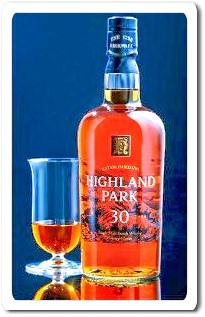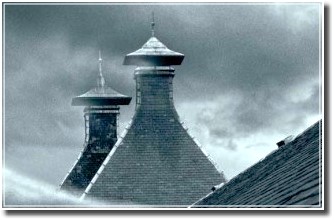| 
Holm Road, Kirkwall
Orkney, KW15 1SU Scotland
Telephone: +44(0) 1856 874619
Viewer's Comments about Highland Park
 Highland Park will forever be associated with Magnus Eunson,
the man often credited with the foundation of the distillery
at the end of the 18th century. Eunson was not a preacher as
received wisdom would have it. He was a beadle (verger, a layperson
who assists in the ordering of religious services) by day and
a smuggler by night, the latter operation based from his bothy
on the High Park above Kirkwall where Highland Park Distillery
now stands.
Highland Park will forever be associated with Magnus Eunson,
the man often credited with the foundation of the distillery
at the end of the 18th century. Eunson was not a preacher as
received wisdom would have it. He was a beadle (verger, a layperson
who assists in the ordering of religious services) by day and
a smuggler by night, the latter operation based from his bothy
on the High Park above Kirkwall where Highland Park Distillery
now stands.
According to W. R. Mackintosh in Around the Orkney Peat-Fires
(1898) Magnus ‘Mansie’ Eunson was "a flesher
[butcher], beadle, and a successful smuggler. In addition
to this he was a born character, brimful of pawky (cunning
& sly) humour and resource, which extricated him from
many a scrape.” Stories of smugglers are forever imbued
with romance and poetic licence, the canny happy-go-lucky
local outwitting the cowardly, corrupt and doltish representatives
of the establishment; in these stories Eunson is shown as
being brave and ingenious enough to enjoy many a narrow escape
from the clutches of the exciseman³.
The best-known Eunson anecdote is recounted by Alfred Barnard
in his seminal Whisky Distilleries of the United Kingdom
(1887); "Hearing that the Church was to be searched
for whisky by a new party of excisemen, Eunson had all the
kegs removed to his house, placed in the middle of an empty
room and covered with a clean white cloth. As the officers
approached after their unsuccessful search in the church,
Eunson gathered all his people, including the maidservants,
round the whisky, which, with its covering of white, under
which a coffin lid had been placed, looked like a bier. Eunson
knelt at the head with the Bible in his hand and the others
with their psalm books. As the door opened they set up a wail
for the dead, and Eunson made a sign to the officers that
it was a death and one of the attendants whispered "smallpox”.
Immediately the officer and his men made off as fast as they
could and left the smuggler for some time in peace.”
Mackintosh tells us that Eunson was not a preacher, nor does
his account suggest that Eunson was an illicit distiller,
however smuggling was virtually a synonym for illicit distilling.
He smuggled principally spirits, but remains most closely
associated with the origins of Scotch whisky from Highland
Park Distillery. By 1798 Highland Park had been founded; later
a syndicate, which, somewhat ironically, included Eunson’s
arresting officer, John Robertson, and his fellow exciseman,
Robert Pringle, purchased the High Park estate, including
the distillery in April 1813.
Excisemen had targeted the Orkney Islands and seized many
illicit stills from 1805. Smuggling on Orkney had become so
prevalent that one Sunday, Mansie’s minister denounced
the activity as being iniquitous and un-Christian. When the
sermon was over, Mansie was asked what he thought of the minister’s
pronouncements; "I think that oor minister is no’
very consistent, for at the very time he was preaching, he
had six kegs o’ as guid brandy under his pulpit as was
ever smuggled.” Clearly, Mansie was confident that his
preferred hiding place for the contraband, under the floor
of the pulpit, was well-placed.
Mackintosh illustrates Eunson’s cunning; he was to
bring some casks of illicit whisky from Deerness into Kirkwall,
so he purposely told a local worthy of his plan to cross the
bridge of Wideford on the Kirkwall road between midnight and
1am with the casks loaded on three horses. The worthy was
a well-known informant so Eunson was sure he would tell the
excisemen of his plan. As expected, the officers were informed
and proceeded to stake out the bridge at the appointed time,
sheltering from the cold of the night under the parapet. They
duly heard the sound of horses and sprang to confront Eunson
only to find that he was heading in the wrong direction with
what turned out to be empty casks. He told the officers that
he had taken the full casks into Kirkwall somewhat earlier
than he had mentioned to the informant, but that he had not
had the heart to keep the officers waiting in the cold for
him until morning.
As with all folk heroes, there are stories of Eunson’s
charm too; he employed his quick wits to engage a party of
guagers (an excisemane) in banter and humour after they caught
him with kegs of smuggled spirit in a cart and insisted he
accompanied them to Kirkwall to deal with the matter. So entertaining
was Mansie that the guagers failed to notice a number of his
accomplices creep behind the cart and remove the kegs one
by one as the party made its way towards town.
By the time they reached Kirkwall there was no evidence left
so no charges could be brought against the smuggler. Finally,
in 1813 Magnus Eunson was arrested for transporting illegal
substances; four packs of untaxed salt and one pack of whisky.
To quote Mackintosh; "At length Mansie was taken before
the Session for smuggling, and he lost his situation as a
beadle. He took this so much to heart that he gave up attending
church.” When Mansie was tackled about his absence by
the minister he had as usual a ready answer. Indeed he insisted
that he did still attend church. The minister said this was
not true but Mansie replied; "My wife is there every
Sunday”. He pointed out that when he got married the
minister who conducted the service said he and his wife were
now one. "Either you or the other minister has tellt
us a lee (lie)” retorted Mansie.
Curiously, though, the case never went to
trial so Eunson was never sentenced. This has led to suggestions
that he was merely the front man of a larger, better-organised
smuggling operation. The disappearance of Eunson following
his arrest contrasts with the meticulously recorded development
of Highland Park from 1818. That was the year that straw-plaiting¹
businessman and farmer Robert Borwick together with his son-in-law,
John Robertson became official co-founders of Highland Park
Distillery. This was around the time that Scotch whisky was
gaining a higher profile; King George IV paid his famous visit
to Edinburgh in 1823, in effect granting Scotch whisky royal
approval, and the following year the Excise Act halved taxes
on spirits. In this short space of time whisky distilleries
were taking out licences, the King developed a fondness for
whisky and tax cuts made Scotch whisky a much more attractive
commercial proposition. Little wonder that expansion followed.
The High Park was now officially called Highland Park and
in 1826 John Robertson moved south, with Robert Borwick buying
out his share in Highland Park. Borwick died in 1840 and the
distillery was taken over by his son, George, who invested
little in the distillery and, upon his death, the value of
fixtures and fittings had shrunk to a mere £104. James
Borwick (George’s younger brother) inherited the distillery
in 1869 but, as a church minister, he felt ownership of a
distillery was inappropriate so he put it up for sale. Initially
there was no interest and the property was offered at £450
on the condition that it was used as a poor-house. However,
in 1876 the distillery was purchased by the newly formed partnership
of Stuart & Mackay. These were great days in the Scotch
whisky industry and business boomed. Highland Park whisky
enjoyed first class status and became (and remains) extremely
desirable to blenders for use as top dressing, to give blends
backbone, structure and flavour; Chivas Brothers, Haig &
Co, George Ballantine & Co and John Dewar & Sons all
became customers. Many of the distillery ledgers can be seen
at the new Kirkwall library archive.
The day book records on March 13th 1876 that Chivas Brothers,
Merchants, Aberdeen bought 117 gallons of whisky at 3/10 per
gallon, making a total of £22, 14 shillings and 4 pence.
On February 7th of that year John Graham, a Glasgow merchant,
bought 734 gallons. In the late 19th century the distillery
was still happy to deal with direct sales; in August when
Dr Bruce of Kirkwall bought two gallons and the Reverend John
Dangerfield of Sanday bought 5 gallons. It reached its peak
during the Napoleonic Wars as trading restrictions meant a
shortage of Italian straw. The industry collapsed in the 1860s
with the advent of cheap, Chinese imports.
On the maiden voyage of his liner, the Pembroke Castle, Sir
Donald Currie visited Kirkwall in 1883. The whisky of Highland
Park made such an impression on him that he took a quantity
with him for the remainder of the voyage, during which the
King of Denmark and the Emperor of Russia expressed their
appreciation of Orkney’s finest. In 1895, on the death
of William Stuart, James Grant became the partner of James
Mackay. The library archive chronicles the alterations and
improvements made to the distillery by Charles C Doig, renowned
engineer and architect.
Typed and hand-written letters from Doig to Charles Hayden
discuss details such as this note from 20th June 1908; "I
am not sure what kind of roof you have on No.10 at present
but if it is of iron only you would require to sark and felt
underneath it, or make the walls of barn at least 5ft; higher
or you will never make good Malt.”
The Grant family retained control of Highland Park until
1937 when the distillery became part of Highland Distillers’
portfolio; the other distilleries in the group were Glenrothes,
Tamdhu, Bunnahabhain
and Glenglassaugh.
Highland Park was run as a wholly-owned subsidiary and retained
the name James Grant & Co for many years.
 The abiding care and attention, the hallmark of Highland Park
production, manifests itself in the distinctive aromatic,
full-bodied floral sweetness of the whisky. Highland Park’s
incomparable balance comes from a tension between the aromatic
Orkney peat and the sweetness of oak casks seasoned with Oloroso
sherry.
The abiding care and attention, the hallmark of Highland Park
production, manifests itself in the distinctive aromatic,
full-bodied floral sweetness of the whisky. Highland Park’s
incomparable balance comes from a tension between the aromatic
Orkney peat and the sweetness of oak casks seasoned with Oloroso
sherry.
The accolade of Best Spirit in the World wasn’t a one-off.
Highland Park has been picking up medals and awards for over
a decade.
Magnus Eunson chose the High Park site because of the outstanding
water source. There may be little evidence of him being an
illicit distiller but, over 200 years of distilling history
on the same site – resulting in Highland Park becoming
the most respected single malt in the world – is evidence
enough that he knew whisky.
Courtesy of the Highland Park
Distillery |

